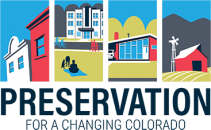Along with our shifting demographics, Colorado’s economic profile is also changing. This section looks at the role that historic preservation plays in supporting two important changing economic trends—the rise of creative communities and the increasing popularity of coworking.
Creative Communities
One major economic trend over the past thirty years has been the movement away from an economy based on manufacturing toward one based on creating ideas, new concepts, and innovation. Often referred to as the “creative” economy, the growth of knowledge-based industries will likely continue. With its high quality of life, Colorado is well-positioned to attract creative professionals, who are highly skilled and educated and typically have choices in where to live. Most cities and towns are looking for ways to attract “creatives,” who bring good incomes and energy both of which help strengthen communities, as well as a wealth of ideas for adapting historic buildings, such as the Loveland Feed and Grain (pictured on page 11). Other examples in Colorado include Trinidad’s Space to Create and the Carbondale Creative District. Programs that provide funding and technical assistance to seed and foster creative industries have sprung up statewide, often in areas with a high concentration of historic buildings, prized for their ability to create a unique community identity. National and state programs are helping communities achieve the intersection of goals combining historic preservation and economic development.
While the term “creative” is often used broadly to refer to this new knowledge-based economy, it is also used to refer more directly to arts and culture. The state helps communities develop this segment of the creative economy through the Colorado Creative District Program, administered by Colorado Creative Industries (CCI), a division of the Colorado Office of Economic Development. Partnered with the Boettcher Foundation, CCI offers select districts technical assistance tailored to their community, networking and training program opportunities, as well as access to grant funding and advocacy tools. A creative district is defined by several key elements: a concentration of arts and cultural organizations and creative enterprises; complementary non-arts businesses, such as restaurants, offices, retail, housing and lodging; and a contiguous area that includes a mix of uses within its boundaries.
Studies show that creative industry workers do not follow the traditional model of moving to a place for employment opportunities; instead, these often self-employed professionals are more likely to choose areas based on quality of life values and are often attracted to historic areas or communities with intact historic assets. Some of the benefits resulting from leveraging unique historic resources to lure creatives include a sense of neighborhood identity, vibrant public spaces, igniting neighborhood revitalization, incubating small business opportunities, and even generating economic development in an otherwise under-performing region.
There is no one definition for preservation. Old buildings, designated historic or not, are increasingly being reused in creative ways to support our 21st-century needs.
Changing Workspaces
Changes in our state’s economy are visible not only in the types of companies moving to Colorado, but also in the types of workspaces increasingly favored by creative firms (and even more traditional companies). These spaces reflect the more mobile and entrepreneurial nature of work in the 21st century, moving away from traditional office settings such as skyscrapers and office parks. These new types of workspaces are often located in historic buildings, seen as “hip” and “cool” places to work among many of the millennial workers that bolster the creative economy.
Co-working spaces allow individuals to lease space in a shared work environment, giving them access to quality office amenities and desk space while also offering the opportunity for interaction and potential collaboration with others. The flexibility provided by this model appeals to the self-employed, start-ups, and other entrepreneurs who value creating social connections with others working in their field. It also provides a cheaper alternative to leasing office space. Co-working spaces are increasingly making their homes in the historic cores of our communities, in part thanks to their unique character and the desire of many millennial workers to be in walkable, mixed-use areas close to transit, housing, coffee shops, and other urban amenities. This trend is encouraging increased rehabilitation and imaginative reuse of the state’s older buildings while simultaneously injecting new life into the hearts of historic communities.

